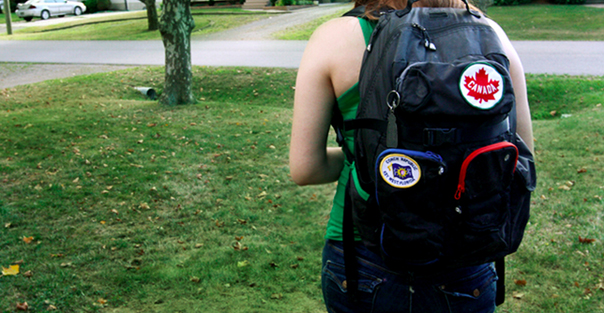How to: Carry the the weight of the world on your shoulders
12:45 PM
The best bag is an empty bag — perhaps something that looks sharp slouched off the shoulder or slung low by the hip. But more often than not, our bags are loaded with all sorts of junk that make them heavy pains in the neck (and back). With the back to school season upon us, kids aren’t the only ones having to haul huge backpacks around. Here’s how to carry a heavy bag (from messenger bags to totes to double-strappers) without needing a trip to the physical therapist (or worse).

(Photo by Lisa Goulet)
CARRY THAT WEIGHT — THE NEED-TO-KNOW
Bags have been a huge boon since very early in human history — ancient texts and drawings show men in particular carrying trinkets around in small bags. Just like us, hunter-gatherers used bags to schlep their stuff (usually wood or food).
More modern packs were used starting in the early 20th century, but they were pretty uncomfortable to wear and heavy. It wasn’t until the 1950s, when avid hiker Dick Kelty developed a lightweight but sturdy bag meant for civilian use, that they became common throughout society. Since then, bags of all shapes and sizes have become a staple of everyday life with ergonomic designs and fancy straps and doodads to make them “easier” on our backs. One 2001 study estimated 40 million American children carried backpacks to school. Smaller bags are just as ubiquitous for young professionals who might need to carry essentials to work like a laptop (guilty), gym clothes (guilty), notebooks (guilty), and more. That extra weight can mess with posture and cause intense pain — especially when taken for long hauls.
If we can’t avoid the heavy stuff, what’s the best way to carry our poor, over-stuffed bags with ease?
TAKE A LOAD OFF — YOUR ACTION PLAN
The bad news is that the best way to carry a heavy bag is to not carry a heavy bag. Lighter loads put less stress on the carrier and minimize all sorts of problems like changes in posture to the cranio-vertebral angle (neck) and spinal lordosis angle (small of the back) [1]. And it’s not just kids: Adults are just as susceptible to back problems (including scoliosis and kyphosis) from carrying heavy loads, with many of those problems stemming from back injuries suffered at an earlier age [2] [3].
Even though young ‘uns are more susceptible to bag-induced pain, there are some simple tips to carry a heavy load with (relative) ease:
- Only carry 15 percent of bodyweight (at most). When carrying a heavy bag, try to keep the load capped at 15 percent of the carrier’s total bodyweight, with a recommended limit of 10 percent [4] [5]. So, for a person weighing 145 pounds, aim for a bag weighing around 21 pounds, at most. Anything heavier significantly alters posture and can lead to longer term spinal problems.
- Place heavier objects on the bottom. Neck straining? Try keeping most of the load low in the bag. One study found that low load placement caused fewer changes in posture and spinal curvature. It also made carrying the bag (relatively) easier for middle-school aged children [1]. Taking breaks (where possible) will also reduce strain. If heavy loads are unavoidable, aim to strengthen core and back muscles to help shoulder the load. This will help keep the spine from twisting and promote better posture.
- Use two straps. One study found that the neck, not the back, was the weak point for carrying loads. To help, try using a bag that has two straps instead of one to help correct posture and more evenly distribute weight [3]. The same study found that women were more prone to pain as were people who spent a large amount of time sitting. If one-strapping is the only option, try to periodically swap sides.
- Even everything out. When packing a bag, try to distribute the weight evenly to avoid postural stress. One study found that an evenly weighted bag decreased lateral spinal motion when ascending and descending chairs [8]. Asymmetrical bags (for example, totes and messenger bags) should follow the same principles but weigh no more than 10 percent of the carrier’s weight to reduce injury.
- Keep it all close to the body. Weight is just one of two factors that can lead to injury. “Postural sway” is the amount of torque and tension placed on the spine by a heavy load. Carrying a bag closer to the body will reduce the amount of sway and stress placed on the spinal muscles [9]. For concerned bag owners, a physical therapist can help find bag with ergonomics best suited to your body type.
Article adapted from: How to Carry a Heavy Bag Without Wrecking Yourself by Zachary Sniderman
Best Teen Diets recommends healthy well balanced eating that includes fruits, vegetables, whole grains, protein and low-fat or fat-free dairy. We offer nutrition information for teens, parents and educators that emphasizes the importance of healthy eating for teens. For more information visit www.bestteendiets.org
Best Teen Diets recommends healthy well balanced eating that includes fruits, vegetables, whole grains, protein and low-fat or fat-free dairy. We offer nutrition information for teens, parents and educators that emphasizes the importance of healthy eating for teens. For more information visit www.bestteendiets.org

2 comments
Do you know where I can purchase the backpack in the picture? Thanks.
ReplyDeleteDo you know where I can purchase the backpack in the picture? Thanks.
ReplyDelete